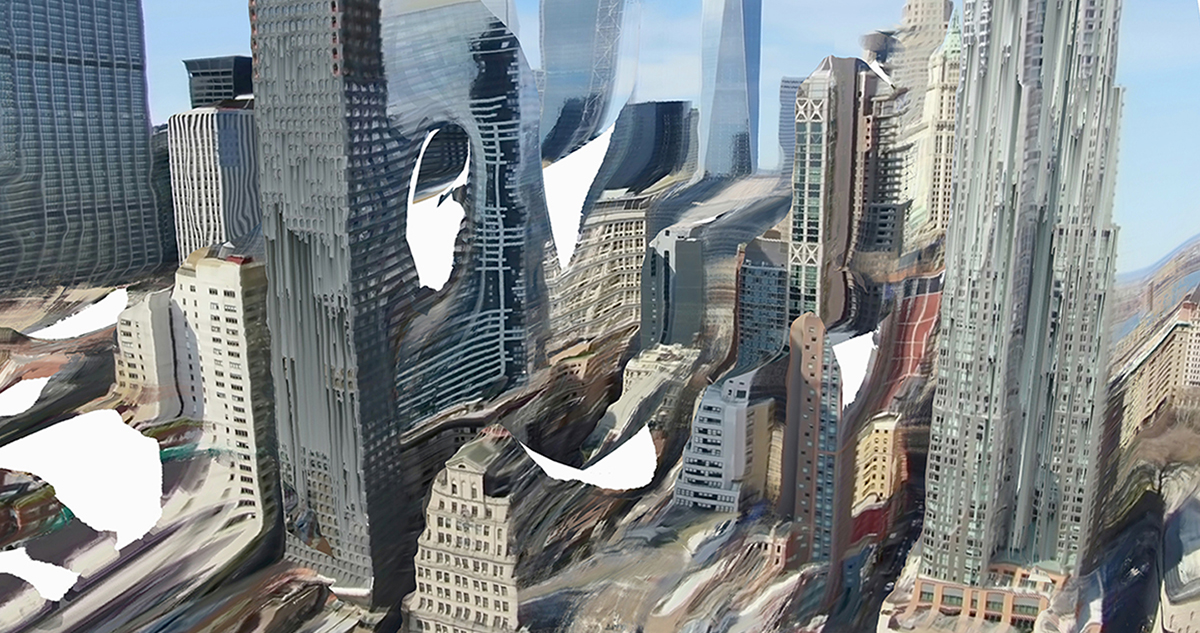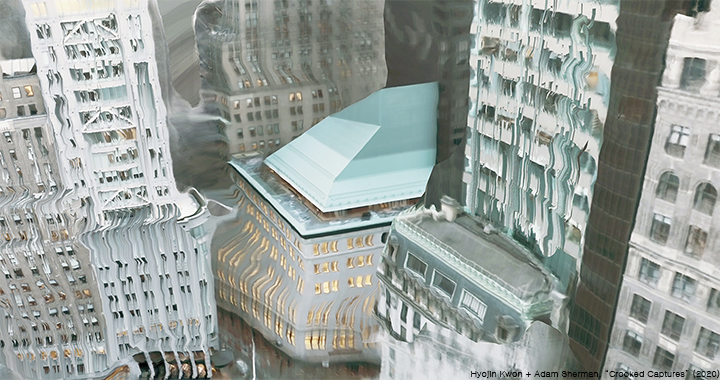January 27 – 31, 2021
2021년 1월 27일 – 31일
M Gallery, CICA Museum
As architectural images viewed on the internet make up an ever greater number of our points of access to the built environment, our relationship to architectural precedents has transformed. While we consume images at quicker speeds and higher volumes, digital representations are taking increasing precedence over their physical referents. This chasm between firsthand experience and digital reproduction has widened with developments in technology for recording images, as devices like drones can capture perspectives previously inaccessible to the human eye. As these tools for image production and consumption continue to evolve, so too will our methods for studying historical precedents.
Crooked Captures treats this proliferation of digital images as fertile ground for new photogrammetric explorations into how two-dimensional image processing techniques can influence three-dimensional form. While photogrammetry, the process of determining spatial measurements of physical objects from photographic inputs, has been an area of investigation for almost two centuries, recent expansions in access to high quality cameras have broadened the potential uses for the technique. Typical photogrammetric applications couple high-fidelity scanning and computing to produce faithful digital copies of physical artifacts and scenes for measuring and surveying. Leading photogrammetry software packages promise “accuracy” and “precision,” championing the exact replication of physical forms in digital space—in other words, “reality capture”—as an indisputable virtue .
Crooked Captures embraces these photogrammetric tools but trades the faithful copy for the distorted reinterpretation through an iterative process translating between two and three dimensions. Frames were taken from publicly accessible drone footage of buildings in New York City found on the internet. These stills were then subjected to various image processing operations to extract, emphasize, and exaggerate certain qualities only attainable through computation. These series of manipulated images were then respatialized as they underwent photogrammetric processing to determine the three-dimensional scenes they depict. Intentional modification of the input data set hindered much recognition of the original physical artifacts, making the photogrammetric operation less a reconstruction and more a construction. The result is a series of anamorphic landscapes in which recognizable images give way to a range of mutations revealed through orbits and zooms.
These methods of computer vision produce readings and misreadings that become the basis for abstraction. The blurs, streaks, bumps, and folds that arise from purely computational operations bear resemblance to the gestural markings of work composed by hand. While the human eyes and brain may work in tandem to identify each constituent component when viewing a precedent photograph, the computer “sees” these input images in a completely foreign manner, parsing through non-hierarchical flattened matrices of pixels. Here, distinctions between discrete elements fade away as edges blur, confusing building components with each other and with their site. These precedents do not enjoy the luxury of the sustained study of cross-referenced drawings or space experienced firsthand; rather, they find themselves reduced to repositories of spatial data, at the mercy of tools that capture, store, and distribute their information. Circumstance therefore determines much of their interpretation, as contingent qualities of color, light, and perspective allow representation to supersede the lost notion of an “original.”
The inescapable presence of precedent throughout the discipline’s history has ensured that architecture always exists in a cycle of consumption and production. Crooked Captures is as much a proposal to imagine new forms as it is one to reinterpret existing buildings. The distortions present in these photogrammetric outputs allow us to speculate on the spaces and forms of occupation that could make up these foreign landscapes. The works seen here anticipate new frontiers in the production of images and tectonics, searching for novel relationships between human experience and computer vision in physical and digital artifacts alike.
인터넷상의 증폭하는 건축 이미지들은 우리가 접근할 수 있는 건축에 대한 시각과 접점등을 무수히 넓혀주며, 건축 작품들과 우리의 인식 관계를 변화시키고 있다. 단편적이고 짧은 순간의 경험일지라도 디지털 표현물들과의 관계들이 건축물의 실제적인 특성과 관계보다도 우선시되고 더 강하게 인식되기도 한다. 건축물의 직접적인 경험과 디지털 복제물 사이의 이러한 간극은 이미지 녹화(Recording) 기술의 발전을 통해 더욱 커졌다. 예를 들면, 드론을 이용해 직접적인 접근이 불가능한 각도에서 건축물을 담아낼 수 있게 되었듯이, 이러한 기술들의 이미지 형성과 소비는 끊임없이 진화할 것이며 이를 통해 우리 건축물 연구 방법들도 지속적인 발전 할 것이다.
Crooked Captures는 디지털 이미지의 급증과 확산을 배경으로 사진측정학(Photogrammetry) 기술을 통해 2D 이미지 프로세싱(Processing) 방식이 3D 형태에 미치는 영향을 연구한다. 사진측정학은 물체의 사진들을 입력매체(Input)로 사용하여 공간을 측량하고 입체적인 형태를 만들어 내는 기술로, 200년이 넘게 다양한 분야에서 연구되어왔고, 고성능 카메라의 발전과 더불어 최근 건축 학문내에서 기술의 잠재력이 늘어났다. 발전된 스캐닝과 컴퓨팅 기술을 바탕으로 실제와 가까운 3D 복제물들을 형성해내며 사진측정학 소프트웨어들은 “정확도”와 “정밀성” 높은 “현실을 캡쳐”해냄을 장점으로 내새우고 있다.
Crooked Captures는 이러한 사진측정학 기술을 받아들인다. 그러나 원본의 재현에 충실한 원래의 기술 신념과 다르게 원본에 대한 작가만의 재해석을 바탕으로 왜곡되고 변형된 표현물을 만들어 내고자하며 반복적인 2차원과 3차원의 변환 프로세스를 통해 사진측정학 기술을 우리만의 고유한 방식으로 활용한다. 인터넷에서 공개적으로 접근 가능한 드론 영상들에서 얻어진 뉴욕 도시의 건축 이미지들은 다양한 이미지 프로세싱 작업들을 통해 오직 디지털 컴퓨테이션으로만 가능한 특정한 특성을 추출, 강조, 또는 과장 시키며 대상화 되었다. 이러한 조작된 시리즈의 이미지들은 사진측정학 작업들을 통해 다시 3차원적인 공간을
형상화하며 입체화된다. 인풋(Input)으로 사용되는 이미지 데이터 셋(Set)는 의도적으로 변형되었고, 이를 통해 만들어진 새로운 결과물은 원형 건축물의 인식과 절충하며 사진측정학 기술을 재구축(Reconstruction)이 아닌 새로운 구축(Construction)을 위해 쓰이도록 하였다. 결과물은 확대와 회전을 통해 특정각도에서 읽혀지는 이미지들이 내포된 3차원의 왜상(Anamorphic) 복합체이다.
이러한 컴퓨터 비전(Computer Vision) 방법들은 관념의 기본이 되는 다양한 해석들을 만들어낸다. 기다란 줄무늬, 흐릿해짐, 요철, 접힘 등의 효과는 컴퓨테이션에 의한 작업들을 통해 생성되었으나 인간이 손으로 가다듬은 제스처적인 자국들과 닮아있다. 주어진 건축물의 이미지를 볼때 우리의 눈과 뇌는 각각 구성하는 물질들을 동시에 인식하며 분석하지만 컴퓨터는 비계층적인 픽셀 매트릭스를 일일히 분석하며 완전히 이질적인 방식으로 본다. 건물 부분들과 사이트의 경계선들이 흐려지며 별개의 요소들간의 차이는 사라지고 디지털 도구들을 통해 정보를 캡쳐, 저장, 그리고 분포시키는 공간적 데이터의 저장소로 함축된다. 이러한 설정은 작품 고유의 해석을 규정하며 색, 빛, 그리고 원근법의 특징적 여부에 따라 “원본 또는 원형”을 대체하며 새로이 표현된다.
Crooked Captures는 이미 존재하는 건축물을 재해석을 통해 새로운 형태로 상상하고 제안한다. 사진측정학 결과물들안의 왜곡들은 익숙하지않은 환경들을 구성하며 공간과 형태에 대한 새로운 사고를 불러일으킨다. 결과적으로, 디지털과 실제 창작물에 관한 인간의 경험과 컴퓨터 비젼 사이의 새로운 관계를 모색하며, 이미지와 텍토닉(Tectonic) 생성의 새로운 방법론을 제시한다.
Hyojin Kwon and Adam Sherman are a pair of designers educated in architecture and engineering with an interest in academic projects and provocations that explore alignments and misalignments between the physical and the digital. Their research investigates architecture’s relationship with digital media, questioning how emerging technologies influence design computation, image processing, and digital fabrication in the production and assembly of prototypes and products. Their work takes on an iterative approach as they embrace a reciprocity between physical and digital realms, unraveling the complex relationships between immaterial design processes and material built works. In doing so, their methodology involves a series of translations: between physical artifacts and digital media, between two and three dimensions, and between conceiving and perceiving architecture.
Hyojin Kwon + Adam Sherman은 디지털과 실제 물질의 관계를 연구, 실험하는 아카데믹 건축 그룹이다. 새로운 기술들이 디자인 컴퓨테이션(Design Computation), 이미지 프로세싱(Image Processing), 그리고 디지털 페브리케이션(Digital Fabrication) 을 통한 건축 디자인에 어떻게 영향을 주는지를 중점으로 디지털 미디어와 건축 사이의 관계를 실험한다. 그들의 디자인과 실제를 넘나드는 실험들은, 디지털 과 실제 오브제, 이미지와 형태 사이, 상상과 실현 사이의 상호적인 기호체계와 시스템으로 변환되고 해석되며 끊임없이 변화하며 새로운 형태의 담론들을 형성함을 지향한다. 권효진은 현재 미국 하버드대학교 건축대학원 (Harvard Graduate School of Design)에서 건축, 디지털 미디어, 디지털 디자인과 테크놀로지에 관련된 강의와 연구를 하는 전임강사 및 연구원이며, 아담 셜먼(Adam Sherman)은 하버드 건축대학원을 졸업 후 뉴욕에서 건축가로 활동하고 있다.

Hyojin Kwon + Adam Sherman, “Crooked Captures” (2020)
